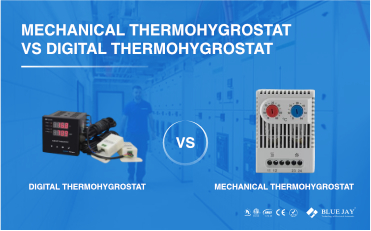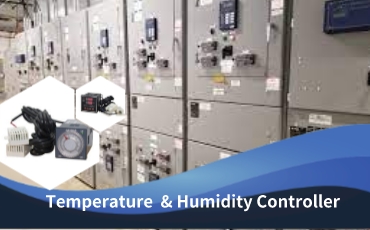
How to Prevent Condensation in Electrical Enclosures?
Probably you are wondering how to prevent condensation in

Thermohygrostats primarily come in two types: mechanical and digital.
A mechanical thermohygrostat is a device that regulates temperature and humidity using mechanical sensors, such as bimetallic strips for temperature control and hygroscopic materials for humidity detection. It operates without electronic components, making it highly reliable and maintenance-free. When preset thresholds are reached, it activates heaters, fans, or dehumidifiers to maintain optimal conditions. Commonly used in industrial enclosures and electrical cabinets, mechanical thermohygrostats offer a cost-effective and durable solution for preventing condensation and ensuring equipment protection.
Mechanical Thermohygrostat
A mechanical thermohygrostat is a device that regulates temperature and humidity using mechanical sensors, such as bimetallic strips for temperature control and hygroscopic materials for humidity detection. It operates without electronic components, making it highly reliable and maintenance-free. When preset thresholds are reached, it activates heaters, fans, or dehumidifiers to maintain optimal conditions. Commonly used in industrial enclosures and electrical cabinets, mechanical thermohygrostats offer a cost-effective and durable solution for preventing condensation and ensuring equipment protection.


Digital thermohygrostat
A digital thermohygrostat (like Blue Jay’s WSK-72 Series Digital Thermostat and Humidity Controller) is an advanced control device that precisely regulates temperature and humidity in electrical enclosures. Equipped with a digital display and electronic sensors, it provides accurate real-time monitoring and allows users to set precise thresholds. When temperature or humidity exceeds the preset values, it activates connected devices such as heaters, fans, or dehumidifiers to maintain optimal conditions. Digital thermohygrostats offer improved accuracy, ease of use, and better adaptability compared to mechanical models, making them ideal for industrial control panels, switchgear cabinets, and other sensitive electrical systems.
Both mechanical and digital thermohygrostats serve the purpose of regulating temperature and humidity in electrical enclosures. However, they differ in operation, accuracy, and functionality. Below is a detailed comparison:
| Specification | Mechanical ThermoHygrostat | Digital thermohygrostat |
| Working Principle | Uses bimetallic strips for temperature control and hygroscopic materials for humidity sensing. | Uses electronic sensors for precise temperature and humidity detection. |
| Control Method | Mechanical switching based on expansion/contraction of materials. | Digital display with electronic switching and precise control. |
| Accuracy | Moderate accuracy due to mechanical components. | High accuracy with real-time electronic sensing. |
| Display & Interface | No display, uses simple mechanical adjustment knobs. | Digital display with adjustable setpoints for better user control. |
| Response Time | Slower response due to mechanical operation. | Faster response with real-time monitoring. |
| Power Consumption | Low, as it operates without complex electronics. | Slightly higher due to digital components. |
| Reliability & Durability | Highly durable, operates without electricity or complex circuits. | Reliable but depends on power supply and electronic components. |
| Ease of Use | Simple setup, requires no programming. | More user-friendly with precise settings and display. |
| Cost | Generally more affordable. | Higher cost due to advanced features. |
| Application | Suitable for basic environmental control where high precision is not required. | Ideal for applications needing precise temperature and humidity regulation. |
| Power Supply | 120V-230V | 85V~265VAC/DC |
| Temparature setting range | 0/+60ºC | -20~99℃ |
| Relative Humidity setting range | 30-90RH% | 0~99%RH |
| Relative Humidity hysteresis | 5% | 5% |
| Reaction time | 60sec | 1s |
| Max. switching current | 3-10A | 5-10A |
| Contact type | Changeover | |
| Installation position | Vertical, din rail | Panel mounting |
| Dimension | 68x53x38mm,69*53*50mm | 72 x 72 x 96mm,48*48*90mm |
| Signal Input | Fixed temperature and humidity, not selectable | High selectability of temperature and humidity channels: 1 temperature and 1 humidity; 2 temperatures, 2 humidity, etc. 1 channel or 2 channels with relay outputs |
Mechanical thermohygrostats are cost-effective, durable, and require minimal maintenance, making them suitable for basic enclosure protection.
Digital thermohygrostats offer higher accuracy, real-time monitoring, and better control, making them ideal for environments where precise humidity and temperature management is essential.
Choosing the right type depends on the specific requirements of the electrical enclosure and the level of control needed.

How to Prevent Condensation in Electrical Enclosures?
Probably you are wondering how to prevent condensation in

Digital temperature and humidity controller – working principle features & types
The digital temperature and humidity controller is an instrument

Why Is a Temperature Humidity Controller Needed in High and Low-voltage Switchgear?
At present, temperature humidity controller is more and more
